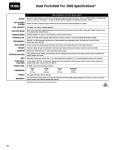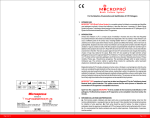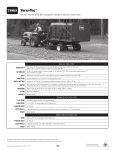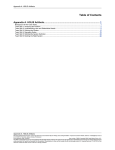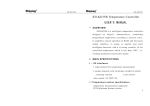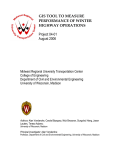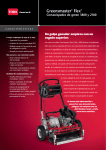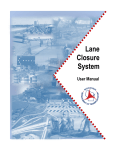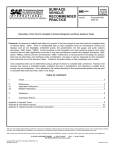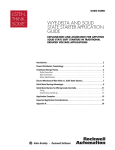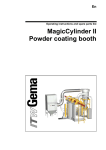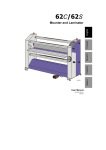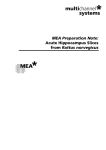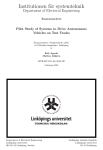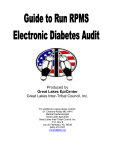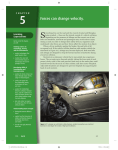Download Crossroads - University of Wisconsin–Madison
Transcript
Crossroads TRANSPORTATION Information Center—LTAP Fall 2004 University of Wisconsin–Madison PHOTO CREDIT: R.J. & LINDA MILLER WISCONSIN DEPARTMENT OF TOURISM Armoring pavement at snowmobile crossings Up North, in the “Snowmobile Capital of the World,” snowmobile traffic can get very heavy. “It’s like being in an anthill during the race,” says Marv Laspa, Operations Supervisor, WisDOT District 7. “I’ve been told that at times there are 200 snowmobiles an hour at some crossings!” All that activity puts a lot of wear on pavement surfaces and bridge decks from the snowmobiles’ carbide-tipped studs. To protect the roads and avoid having to patch them, Laspa borrowed an idea from Michigan—gluing durable stone to the crossing surface with epoxy-like polymers. The first surfaces were installed in 2000 at busy Minocqua and Eagle River crossings. The wear layers worked well, and others were added throughout the District’s eight counties. About 50 crossings are now armored. “I think it saves quite a bit on the pavement,” says Laspa. “I just can’t imagine what we’d be fixing on the road if we didn’t have this armor.” The material costs $1500-$2000 per crossing to install and lasts several years, depending on how heavily the trail is used. The process is pretty “low-tech” and uses common equipment. Local road crews can do it themselves. Some important elements are getting very hard stone (7 on the Mohs scale), having a moderate air temperature during application, tapering the downstream edge so plow blades ride over it more easily, and making saw cuts to reduce pavement cracking. The materials were originally designed for use on rigid concrete bridge decks, where they work quite well. However, when applied to asphalt, the coatings can sometimes delaminate. The polymer is stiffer than blacktop and expands and contracts differently. Overall, the snowmobilers seem happy. The material delineates the crossing, making it easier for drivers—vehicle and snowmobile—to see. Although there is some concern about wear to the studs, as taxpayers the snowmobilers appreciate the savings in road repairs. “It also reduces the amount of negative sentiment,” Laspa says. Having a level pavement instead of a dip where the surface was patched helps keep the non-snowmobilers happy, too. One potential problem is that some crossings move when a snowmobile club loses its lease for the trail. It’s important to have some assurance that the trail will continue to be used, Laspa notes. A thermoplastic option Michigan DOT began studying the coatings in 1997. They identified issues like potential for snowplow blades to peel them off, and developed installation procedures. In 2000 they also learned of and began testing a different approach: hot-applied thermoplastic. The material, imported from Norway, is applied in three layers with fine-grade silica sand on top for skid resistance. The thermoplastic costs about the same as the polymer, but works better on continued on page 5 Inside Idea Exchange Beloit recycles street sweepings ..... Signing & pavement marking Q&A .. 2 2 Erosion control techniques updated . 3 ..... 4 ........... 5 ............ 5 Pavement demo draws a crowd Snowmobile crossing signs New PASERWARE release Inspect, plan culverts in Fall ......... 6 WISLR update . . . . . . . . . . . . . . . . . . . . . . . . . 6 Resources ............................. 7 Calendar . . . . . . . . . . . . . . . . . . . . . . . . . . . . . . . 8 2 Fall 2004 Idea Exchange Crossroads Signing and pavement marking by Tom Heydel, Traffic Operations Engineer, WisDOT District 2 Beloit recycles street sweepings Most years the City of Beloit hauls about 1600 tons of street sweepings to the landfill; through July this year they only landfilled about 260 tons. What made the change? The city is running the material through a screen to separate the fines from the trash and debris. The fines become clean fill for Streets and Parks Department uses; only the debris is hauled to the landfill. “By the end of 2004 we expect we will have diverted 60-65% of the sweepings from the landfill,” says Dick Kinzer, Beloit Streets Supervisor. Not only does the city save on landfill tipping fees, they use less labor, and also save money by not buying soil for fill. Just how clean is the soil, and will it grow anything? The quick answers are: “very” and “yes.” A Beloit employee trained in testing procedures took samples and sent them to two different labs to be tested. “The results came back completely clean except for a slightly elevated sodium content,” says Kinzer. “It’s clean fill and can be used for just about anything. And it is fertile enough to grow oats on its own,” he says. A street crew member suggested using a drum separator and Trommel screen on street sweepings, back in 2000. After an initial demonstration in 2001 Kinzer and DPW Director Chris Walsh made a proposal to the City Council. They estimated savings of $14,000 per year, and projected that the equipment would pay for itself in six to seven years. With the blessings of the Council, crews tested separator screens from several vendors. Ultimately they ordered a machine with two conveyors from Wildcat Manufacturing for a cost of $89,000. It was delivered late in 2002 and put into service in 2003. “It is very simple to operate and has worked perfectly with no breakdowns,” says Kinzer. “It is a tremendous piece of equipment!” In just the first half of 2004, Kinzer estimates the Streets Department has saved $11,000 in tipping fees. They won’t buy any clean fill at all this year, saving another $4500. Cutting the volume by 60% also cuts the hauling time. Kinzer calculates that they have spent 5.5 days hauling debris to the landfill so far in 2004, rather than the 18 days it would cost under the old system. At this rate, the machine will likely pay for itself in three or four years. “It has helped allow us to do other duties instead of hauling to the landfill,” Kinzer says. “We can be out crack sealing streets and getting more infrastructure work done. Also, we save fuel, and there’s less wear and tear on the trucks.” Building on this success, Kinzer’s next experiment is to see if they can screen trash out of fall street sweepings and reserve the leaf matter. The clean compost could be used to enrich the pile of fill and soil. It appears that recycling street sweepings is a winning strategy for Beloit. Where can I find basic information on signing and marking besides MUTCD? Two T.I.C. publications provide basic information on signing and pavement markings: Wisconsin Transportation Bulletins #7 and #9. Available from the T.I.C. either in print or on the Web site. What should I consider when establishing a speed limit for a roadway? See the T.I.C. publication Setting Speed Limits on Local Roads (No. 21) for an overview. In general consider: • Road characteristics: land and shoulder widths, curves, sight distances • Roadside development; driveway spacing • Prevailing traffic speed • Parking practices and pedestrian activity • Crash numbers in the past 1–2 years • Level of speed enforcement Can I apply Part 5, Low Volume Roads, in the MUTCD to a city or town? Part 5 is only for roads lying outside of built-up areas with a traffic volume of less than 400 vehicles per day. The roads can be paved or unpaved. What does retroreflectivity mean in pavement marking? Glass beads are dropped into the wet paint of pavement markings. At night the beads reflect light from vehicle headlights back to the driver’s eye. This is called “retroreflectivity” and is different from “reflectivity” where light is dispersed rather than reflecting back to the driver. What does a solid or a broken line mean? A double line indicates maximum or special restrictions. A solid line prohibits or discourages crossing. A broken line indicates a permissive condition. For example on a two-lane road, a double yellow centerline means passing is prohibited. A broken yellow line means pass with care. Crossroads For more information on recycling street sweepings, contact Dick Kinzer at 608/364-2929. Information on roads and bridges for local officials. Published quarterly by the Wisconsin Transportation Information Center, part of the nationwide Local Technical Assistance Program (LTAP). Crossroads is produced with assistance from the Federal Highway Administration, the Wisconsin Department of Transportation, and the University of Wisconsin–Extension. Non-profit organizations are welcome to reproduce published articles. Please contact us first for updates or corrections. Wisconsin Transportation Information Center (T.I.C.), UW–Madison Dept. of Engineering Professional Development, 432 N. Lake St., Madison, WI 53706. Phone: 800/442-4615 Fax: 608/263-3160. Don Walker, director [email protected] Ben Jordan, staff [email protected] Steve Pudloski, staff [email protected] Susanna Fuerstenberg, program assistant [email protected] Lynn Entine, writer and editor Entine & Associates Susan Kummer, graphic artist Artifax Crossroads Fall 2004 Erosion control techniques updated For over a decade people doing construction have turned to the Wisconsin Construction Site Handbook, known as the “Blue Book,” for technical specifications on soil erosion and sediment control. Technology has changed; research and experience have greatly expanded; new requirements are in place. It was time for an update. New standards are now available on DNR’s Web site for more than two dozen control methods— from dust control to vegetation buffers. They specify the minimum requirements needed to plan, design, install, and maintain a wide array of conservation practices. Designed to be easily and regularly updated, they were developed by a statewide Standards Oversight Council (SOC) with membership from DNR, WisDOT, the Department of Agriculture, Trade and Consumer Protection, and other agencies. The SOC works through and coordinates the needs of diverse interests in developing technical standards for conservation practices. The new standards reference products available on PAL (the WisDOT Product Acceptability Lists) which lists tested and approved erosion control products. Using it will help you select and properly install erosion mats, soil stabilizers, tackifiers, inlet protection, temporary ditch checks, in-stream sediment traps, and concrete block revetment systems. The PAL is updated three times a year and lists products by name and manufacturer. Using the revised standards should make it easier and faster to develop erosion control plans for construction projects. It can also streamline the permitting process for most of them. They are effective for the 2005 construction season. “We have been doing erosion control plans and implementation for 10 years Wet detention pond. plus, but now we have to do it for sites down to one acre instead of five,” says Dan Fedderly, Administrative Coordinator of the Wisconsin County Highway Association (WCHA). “The new standards take existing processes and ensure that we are using the best materials and methods available. On road projects it affords a certain degree of assurance that when you put these measures in place they will achieve the objective we’re looking for.” Fedderly was a member of the statewide council advising DNR on the standards. To assist local road agencies, WCHA created a set of standard erosion control plans and summarized them in a matrix. The matrix tells which erosion control method to choose for each common condition or situation. It is available on the WCHA Web site, and an expanded version is part of the WisDOT Facilities Development Manual. Many counties have made the permitting process easier and faster for their transportation agencies by adopting standard plans and forging agreements between zoning, land conservation and highway agencies. In Dane County, for example, a routine permit request and approval can be completed the same day via e-mail by referencing the standards. 3 consideration into the initial design phase of a project. The goal is to develop designs that minimize pollutant movement, maintain vegetative buffers, and limit peak flow rates to protect surface waters after construction is completed. Also, infiltration will need to be designed into the project where feasible. A technical standard for evaluating sites for stormwater infiltration was finished in May of this year. Wet detention ponds are one tool for managing runoff and have become a familiar sight in many parts of the state. Technical standards for them were completed in 2003. Swales are a newer method being designed into some new roads in place of conventional ditches. These wider, flatter vegetated areas let water move slowly and will allow for pollutants to settle out and provide for some infiltration. Another method is vegetated buffer strips that separate impervious areas like parking lots from streams. Like swales, the buffer slows water movement and filters pollutants. Technical standards for swales, infiltration basins and bioretention, were completed in August. Those for buffers are due in 2005. Stormwater after construction Another method of pollution control that takes effect this fall is Post-construction Stormwater Management. These rules apply to new construction projects submitting a Notice of Intent to DNR after October 1. While the rules are primarily aimed at developments, they would also apply to projects that increase the carrying capacity of a road—expanding from two lanes to four, for example. The new rules put runoff management Swale replaces ditch. In summary, if you are responsible for a construction project: 1) Know if a stormwater erosion control permit is required and from where (county, DNR, municipality). 2) Use the new standards, PAL products, and standard plans that meet local and state requirements. 3) If a DNR permit is needed, submit a Notice of Intent as soon as possible but after appropriate erosion control and storm water management plans have been developed. 4) Follow the plans and permit requirements during construction. Local information resources include county highway, land conservation and zoning departments and regional DNR stormwater contacts. For technical standard and matrix Web addresses see Resources, page 6. 4 Fall 2004 Crossroads Pavement demo draws a crowd better than any video we could show in a classroom. They really appreciated the opportunity to see the work live,” says Ben Jordan, T.I.C. program coordinator. “All the pieces fall in place when you see them and get your hands on the materials.” Offering many different processes also introduces people to things they don’t use every day. They get a chance to become comfortable with different materials and technologies, Jordan says. Thanks to contributors The Town of Dell Prairie for providing roads. The Adams County Highway Department for traffic control for the demonstrations. The FHWA Wisconsin Office for supplying hardhats and safety vests. The Wisconsin Asphalt Pavement Association for coordinating contractor participation in the demonstrations. Special thanks to those who provided materials, equipment and labor for the demonstrations: City of Beloit Spray injection patching Bergman Companies, Inc. EAU CLAIRE Infrared surface patching Fahrner Asphalt Sealers, Inc. PLOVER Slurry seal and crack routing and sealing Scott Construction, Inc. LAKE DELTON Chip seal Routing helps provide a clean reservoir for long lasting crack sealing. ▲ ▲ The Transportation Information Center held an Asphalt Pavement Maintenance Demonstration Day on July 7th at Chula Vista Resort in the Town of Dell Prairie. More than 100 people attended, representing towns, villages, cities and counties throughout Wisconsin. Representatives from WisDOT, contractors and material suppliers also attended. Demonstrations of crack routing and sealing, infrared surface patching, spray injection patching, and chip seal and slurry seal surface treatments showed maintenance procedures that can help increase the service life of asphalt pavements when used around Wisconsin. Routing removes debris and deteriorated material from an asphalt crack, creating a clean, uniform reservoir for the crack seal material. Crack sealing can increase the life of a road by keeping water out of the pavement and base. Spray injection patching uses a multifunction machine where a single operator can blow a pothole clean with air jets, apply tack coat, and place and compact the asphalt mixture. The result is a durable patch for potholes and low areas on the pavement surface. Infrared surface patching heats the existing asphalt surface layer so that the material can be reworked and additional material can be added. With careful attention to hand leveling and compaction you can produce an excellentriding patch that is as durable as the surrounding pavement. Chip seal and slurry seal treatments seal the road surface, provide a new wearing surface, and extend pavement life. The Town of Dell Prairie chip seal demonstration used a chip that was precoated with asphalt at the plant. Precoating chips can limit dust, improve chip retention, and give a black surface appearance. Slurry seal is a mixture of aggregate and asphalt emulsion applied in a thin layer. Often used on local streets in cities or villages, it makes the surface look like the original asphalt and produces very little loose aggregate. Participants watched crews demonstrate these maintenance techniques live on the street and heard about how to apply the processes from the people who actually do the work. “One person told me that actually seeing the work being done on the road was so much ▲ Slurry seal gives good surface protection and appearance of new road surface. ▲ Infrared patching and rolling provide excellent appearance, a smooth ride, and long lasting patches. ▲ Chip seals provide cost effective preservative treatment. Calibrated equipment and trained crews are required. Pre-coated chips limit dust and give a new asphalt surface appearance. Crossroads Armoring crossings Fall 2004 from page 1 asphalt, expanding and contracting at a similar rate, while it takes less time to install—2-4 hours versus 6, says Laspa. Michigan is still using some epoxy materials, but has mostly converted to the hot-applied thermoplastic. “The big reason is ease of application and its compatibility with asphalt,” says Tom Miller, M-DOT Engineering Technician. “The only wear we see is from our own snow plows. The snowmobiles hardly do any damage at all,” says David Widrig, Transportation Maintenance Coordinator, M-DOT Cadillac office. “If it’s applied right and we get a little taper on the downstream edge, then the plows don’t bother it at all.” In Wisconsin, Laspa’s District installed thermoplastic at an Oneida County crossing last year as a test. They may put it in at other high volume crossings later this year. The thermoplastic’s light, “battleship grey” color is also beneficial, making the crossing more noticeable, says Laspa. Currently the thermoplastic material, called Nor-Skilt protective coating, is only available from Clark Highway Services, Lake City, Michigan. It requires special equipment for installation. Whatever the material, the pavement armor seems to be doing a good job. “It’s a win all the way around,” says Laspa. For specs or more information, contact Marv Laspa, WisDOT District 7, 715/ 365-3490, [email protected] Snowmobile crossing signs by Tom Heydel, Traffic Operations Engineer, WISDOT District 2 Snowmobile crossing signs are now specifically shown in the 2003 MUTCD under non-vehicular traffic signs (2C.41). These signs “Should be used only at locations where the crossing activity is unexpected or at locations not readily apparent,” according to both the 2000 and 2003 MUTCD. The 2000 MUTCD Wisconsin Supplement, currently in effect, says to place them where authorized snowmobile trails, as defined in Section 350.01 (17) Wisc. Stat., cross the highway if there is a sight restriction issue or crash history or potential. The same language will most likely be used in the 2003 Wisconsin Supplement to the MUTCD due out by the end of 2004. The agency with jurisdiction of the roadway decides when and where to install the snowmobile crossing warning sign. They should consult the DNR to make sure it is an authorized trail. The criteria for installing them should be per the MUTCD, which does provide some latitude for engineering judgment. Take into account crash history, crash potential and sight restriction. Regarding sight restriction, the visibility chart is as follows: 55 MPH speed limit = 495’ minimum visibility due to curves and hills 45 MPH = 360’ 35 MPH = 250’ 25 MPH = 155’ Visibility for this purpose refers to how far the snowmobile driver can see a vehicle on the roadway as the vehicle approaches. Other factors to consider are roadside sight restrictions such as trees and intersections very close to the trail crossing that could distract a vehicle driver who may not be aware of a crossing at that location. It is the ultimate responsibility of the snowmobile driver to yield the right-of-way to the motorist on the roadway. If it is decided to install a sign on the road, then it should be installed in advance of the trail crossing. An AHEAD plaque is also desirable (although not required) to be installed under the advanced warning sign. In this way, the vehicle driver knows the trail is ahead and not at the sign. A warning sign can also be added at the crossing itself to supplement the advanced sign in select situations where the trail is very obscured. 5 New PASERWARE release by Steve Pudloski PASERWARE 3.0 will be released this November in a series of one-day training courses beginning in November and continuing through Spring, 2005. (See Calendar, pg. 8, for initial course dates.) Only training participants will receive the version 3.0 disk and user’s manual. PASERWARE 3.0 is very different from previous versions. It is written to be compatible with the data structure of WISLR, the state local roads database, and to support data transfer between the two. This will be useful in uploading pavement condition ratings to WISLR in December, 2005. V. 3.0 has two separate databases that will be downloaded from WISLR. The first contains all of the road names with the intersections on each road and the distance between the intersections. The second database contains all of the pavement information, including detailed physical and operational attributes. Because pavement sections are described using the ON/AT system, there is a direct link between the two databases that allows pavement sections to be precisely located and displayed using the WISLR mapping capability. Because of WISLR/PASERWARE compatibility requirements, there are a number of data control elements in PASERWARE 3.0 and a number of new audit reports that help users check the accuracy of the downloaded data and verify the correctness of any changes that they may make. Like previous versions of PASERWARE, users can inventory their local roads and conditions, keep a maintenance history of work done on their roads, calculate the costs of fixing their roads, create yearly budgets, and project the condition of their road system for various budget amounts and project selections. The analysis in PASERWARE is not only helpful in preparing budgets and capitol improvement programs, but also in presenting information about the consequences of budget decisions to elected officials and the public. Users with maintenance history files will have the option of exporting them to the new version. See the T.I.C. web page for specifications and ordering information related to PASERWARE. 6 Fall 2004 Inspect, plan culverts in Fall Record rainfalls this year put a lot of stress on drainage systems along roads. How did your culverts perform? The fall months— between mowing and plowing seasons— are a good time to inspect culverts. You can do minor maintenance before it snows and plan for next year’s replacements. An early start gives you plenty of time to secure permits, get design help, and bid or schedule the work. To spot culvert problems, use the R-WEB method: Road, Waterway, Ends & Barrel. ROAD Is there a change? Sagging, cracking, or sideslope failure? WATERWAY Is the culvert clogged with silt? Are the ends overgrown with vegetation? Is there scouring, infill or debris in the stream or ditch? Is the stream lined up with the culvert? Check for high water marks that indicate ponding. ENDS Have they moved, settled, cracked? Has the stream or waterflow undermined the ends, scoured into the streambed or ditch, or seeped along the outside, creating holes by removing soil? BARREL Has the culvert’s shape changed? What about joints and seams? Rips, tears, pitting, cracking, spalling? Minor maintenance can include clearing the clogged culvert, adding a flared end treatment, or placing rock rip-rap around the culvert ends. If clogging is the problem, find where the sediment and debris have come from and try to correct the problem at the source to prevent a repetition. If the culvert is in a wetland or carries water from a navigable stream, you must contact the DNR before you do any maintenance or replacement work. Planning and permits When culverts need replacing, it is up to you to order the right type, size, length, and end treatment; spec the proper instal- lation; and get the proper permits before starting work. The T.I.C.’s revised publication on culverts can help you understand the process. You may need one or more permits for the project, depending on the location and size of the culvert, extent of the work, and the county or municipality you’re in. Most culvert jobs are routine—replacing a cross-drain with another of the same size. However, you can’t tell just by looking if a navigable stream or a wetland is involved. Some streams that are dry part of the year can still be officially navigable, for example. Also, you are responsible for erosion control during and after construction, and you must submit a plan and secure a permit if the project will open one or more acres. Erosion control ordinances are even stricter in some counties. Dane County, for example, requires a permit for any disturbance over 4000 sq. ft., 400 lineal feet of a road ditch exposed, or any disturbance if the project is within 300 feet of a navigable waterway. The best practice is to start early. Towns and smaller communities can usually contact their county highway department for help. Most counties will assist with sizing the new culvert and should know the local permitting process. Some will contract to do the installation. If a stream or wetland might be involved, or you are not sure, contact the DNR Transportation Liaison as soon as possible. The time required may be as quick as a phone call, or as long as a couple months. “We look at several hundred of these a year,” says Al Stranz, one of three DNR Transportation Liaisons for the 16 county Northeast Region. “I might have been there before and know the area. But it’s best is to leave enough lead time so I have some snow-free time to go out and look at it.” Wait until summer and it could take longer. “If we get the request during the busy summer months, it could take a while,” says Kathy Bleser, Transportation Liaison in the South Central District. Once you get your permit, be sure to read it and follow any instructions during Crossroads installation. It might require the work be done only in certain months, or that the pipe be buried 12 inches into the stream bed, or that you use a specific erosion mat. “We require fiber or jute types of erosion mats along streams where animals need to get in and out,” says Bleser. “We’ve had situations where we found some rare species of frog caught in the net of the netted type of mat.” It’s not just about the permits, though. Doing it wrong and having to do it over can cost a lot. On the other hand, your culvert replacement might help improve a trout stream, or make it easier for bass to reproduce. Local roadway agencies are an important part of the tourism industry, not just in providing good roads, but also in protecting and enhancing the water resources that draw those economically important visitors. T.I.C. Bulletin No. 15, Culverts, is in print and on our Web site. See the web links on page 7 to locate your DNR Transportation Liaison. WISLR update by Mary Jo Trapani-Collins How do you effectively and inexpensively address training needs for the Wisconsin Information System for Local Roads (WISLR) for up to 1923 municipalities statewide? One solution is to offer Computer Based Training (CBT) on CD, or Web Based Training (WBT) accessible online in WISLR, in addition to face-toface training. Interactive training using a computer helps make learning easy and interesting. Users can access training at their convenience and repeat it on demand. As positions turn over, new users can get up-tospeed quickly. In addition, modules are easy for WISLR to update so users stay current with new functionality. Not only do many of the training topics give details about what is available in WISLR, but the modules also demonstrate how easy WISLR is to use by simulating WISLR screens, maps, and reports— including brief, helpful explanations. Pavement rating submittals Every two years, Wisconsin counties, cities, villages, and towns are required to submit pavement ratings to WisDOT. Pavement rating data is then loaded into WISLR for use by municipalities and the state. Submittal statistics for 2003 (as of July 2004) are: • Municipalities submitting ratings: 95% • Municipalities not submitting: 102 • Percentage of submittals loaded in WISLR: 93% Crossroads Fall 2004 7 Resources Publications Videotapes Printed copies are available free from the T.I.C. while supplies last, or download from the T.I.C. Web site http://tic.engr.wisc.edu or other listed site. Videos are loaned free through county UW-Extension offices. Printed copies of the current T.I.C. Video Lending Library Catalog were distributed in August. A complete list of videos is on the T.I.C. Web site. The following videos are new. FHWA Techbrief, A Review of the Signalized Intersections: Informational Guide, (FHWA-HRT-04-091) gives diagrams, figures, and brief descriptions of the chapters in the FHWA publication due out this Fall. www.tfhrc.gov/safety/pubs/04091/ This public information video covers the dangers of children building snow forts and playing in snow piles next to a public street. Intended to educate children and snow plow drivers. Snow and Ice Control (series), IL DOT, 2001, 59 min. #17625 Introduction and Plows, 10 min. Shows basic types of plows and their use. NEW! Getting Across – Aquatic Organisms and Road-stream Crossings: A Brief Introduction, U.S. Forest Service, 2003, 6 min. #18665 Wisconsin Transportation Bulletins #7 Signing for Local Roads, #9 Pavement Markings, and #15 Culverts – Proper Use and Installation. UPDATED! Hopper and Tailgate Spreaders, 8 min. Covers types and details on controls, hookup, loading and calibration Weather Forecasting, and Chemical Application, 8 min. Explains use of salt and calcium chloride, storage and both dry and liquid applications. Types of weather forecasting tools including DTH and RWIS. Brief introduction to the impact of road culverts in stream habitat. Provides awareness of the issue and problems to a general audience. Digital resources The T.I.C. Web site http://tic.engr.wisc.edu contains a list of all the Web addresses in this issue. The links are active. To visit, just click on the link you are interested in. Getting Across – Aquatic Organisms and Road-Stream Crossings: General Overview, U.S. Forest Service, 2003, Pre-Storm Preparation, 13 min. Stresses importance of taking care of equipment. Includes preseason check, daily equipment checklist, radio use, dry run, and appropriate clothing. 17 min. #18666 Wisconsin DNR Storm Water Construction Technical Standards. www.dnr.state.wi.us/ org/water/wm/nps/stormwater/techstds. htm#Post Shows details of the impact of road culverts on stream habitat and aquatic species. Examples of good culvert installation are provided. Intended for general, non-technical audience. The Wisconsin DOT Erosion Control Product Acceptability List (PAL). www.dot. wisconsin.gov/business/engrserv/pal.htm Plowing and Spreading Techniques, 12 min. Highlights challenges with storm types and safe operating techniques. Includes truck plows, wings, and graders. A Snowplow – Cool! Minnesota Local Road Research Board, 2001, 9 min. #18679 A listing of Wisconsin DNR Transportation Liaison Staff. www.dnr.state.wi.us/org/es/ science/DOT_liaison_list.pdf Final Clean Up, 3 min. Reader Response Crossroads Transportation Information Center University of Wisconsin–Madison 432 North Lake Street Madison, WI 53706 Call, fax, email or visit our Web site: phone 800/442-4615 fax 608/263-3160 email [email protected] Web http://tic.engr.wisc.edu/ ✁ If you have a comment on a Crossroads story, a question about roadways or equipment, an item for the Idea Exchange, a request for workshop information or resources, or a name for our mailing list, fill in this form and mail in an envelope to: Please put me on your Crossroads mailing list. Please send me information on ________________________________________________ ____________________________________________________________________ ____________________________________________________________________ ____________________________________________________________________ My idea, comment or question is ______________________________________________ ____________________________________________________________________ ____________________________________________________________________ ____________________________________________________________________ (We’ll contact you to get more details or answer your question.) Name __________________________________________ Title/Agency __________________________________ Address ____________________________________City Phone ( ) ______________________ fax ( __________________ State ____ Zip ____________ ) __________________ email __________________________ 8 Fall 2004 Calendar T.I.C. Workshops Details and registration forms are sent to all Crossroads recipients prior to workshops. Registration begins after forms are sent. Winter Road Maintenance The T.I.C.’s annual workshop on preparing for winter operations covers equipment preparation, the latest on ice control materials, operations planning, and new equipment details. A great opportunity to share experiences and tips for better winter operations. Sep 13 Sep 14 Sep 15 Sep 16 Eau Claire Green Bay Waukesha Barneveld Sep 20 Rhinelander Sep 21 Cable Sep 22 Tomah Tire Maintenance and Repair Learn why tires fail and how to implement a tire maintenance program. Covers safety issues, types of tire and rim defects, and when not to make repairs. Learn about service life, when to retread or recycle, and see shop demonstrations on effective, safe repairs. Intended for managers and shop staff directly responsible for tire maintenance. Oct 11 Janesville Oct 12 Friendship Oct 13 Manitowoc Oct 14 West Bend Crossroads Bridge Maintenance on Local Roads Get details on maintenance/repair methods for local road bridges including practical tips for steel, concrete and timber bridges. Learn to plan and prioritize bridge maintenance. Find out about Wisconsin’s bridge inspection program and how to check small bridges and culverts it doesn’t cover. Nov 30 De Pere Dec 1 Waukesha Dec 2 Barneveld Dec 6 Rhinelander Dec 8 Eau Claire Dec 9 Tomah Work Zone and Flagger Safety For road supervisors and maintenance personnel who plan and set up work zones. Covers traffic control devices, work zone components, and doing different set-ups, including mobile and flagging operations, using the Wisconsin Pocket Guide to Workzone Safety and Flagger’s Handbook. Fee: $45 Jan 12 Jan 13 Jan 14 Jan 18 Tomah Barneveld Brookfield Eau Claire Jan 19 Jan 20 Jan 21 Cable Rhinelander De Pere Other opportunities The APWA Snow Plow Roadeo is a friendly competition on a challenge course at Lambeau Field in Green Bay, September 22. To register contact T. J. Sorensen, Motor Services, City of Green Bay, 920/492-3751. UW–Madison courses Local government officials are eligible for a limited number of scholarships for the following Engineering Professional Development courses held in Madison Soil Engineering for Non-Soils Engineers and Technicians, Sep 13-14 Geosynthetics for Beginners, Sep 15-16 Managing Snow and Ice Control Operations, Oct 4-5 Storm Sewer System Design, Oct 18-19 Storm Water Detention Basin Design, Oct 20-21 Integrating Maintenance into Street and Highway Design, Nov 15-16 Pavement Design, Nov 15-16 Local Transportation Issues (WisLine) The T.I.C. and UW-Extension Local Government Center present an annual transportation series at WisLine Teleconference locations in Wisconsin. Call 608/262-9961 or visit www.uwex.edu/lgc for more information. Evaluation and Rehabilitation of Pavements, Nov 17-18 Effective Bridge Rehabilitation, Dec 1-3 Highway Bridge Design, Dec 6-8 Address incorrect? Please call or write us with the correct information Route To Do not use for return mail University of Wisconsin–Madison College of Engineering 432 North Lake Street Madison, WI 53706 Nonprofit Organization U.S. Postage PAID Madison, Wisconsin Permit No. 658 TRANSPORTATION Information Center — LTAP phone 800/442-4615 • fax 608/263-3160 • email [email protected] Local Technical Assistance Program (LTAP) Printed on recycled paper








